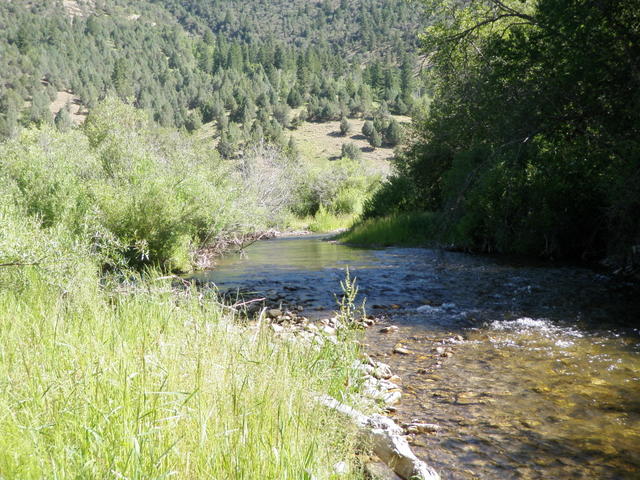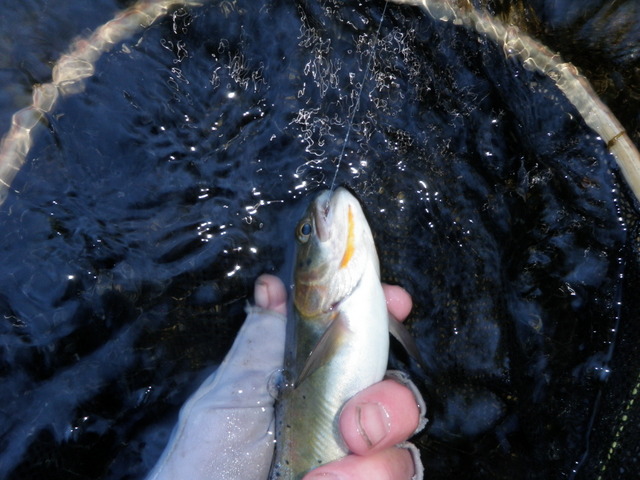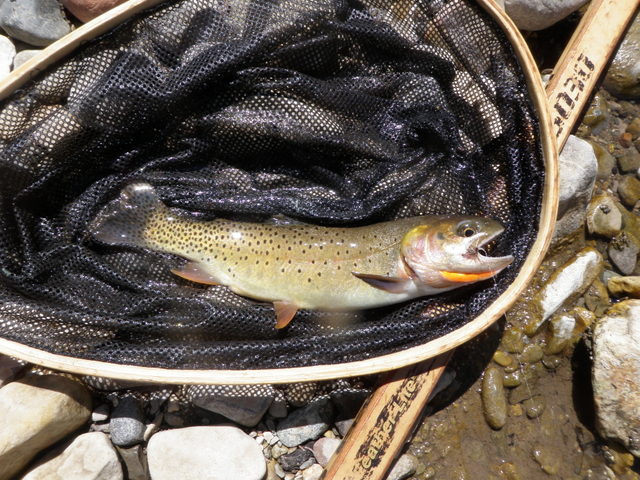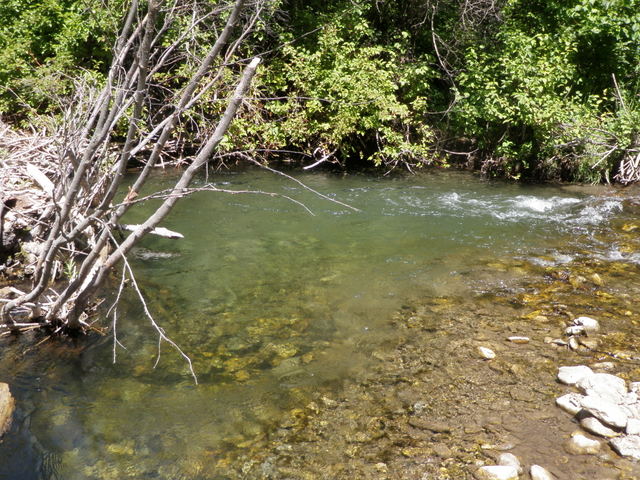Time: 9:30AM – 12:30PM
Location: Trailhead to Rainey Creek Trail then upstream approximately a mile
Fish Landed: 7
Rainey Creek 07/27/2014 Photo Album
Rainey Creek is a small tributary of the South Fork of the Snake River within five miles of the Hansen Guest Ranch where Jane and I were staying in Swan Valley, Idaho. After I purchased my license on Saturday afternoon, we took a brief drive to check out the small stream before I ventured to the South Fork of the Snake River. I drove a long distance to fish the Snake, but now I was considering investing some of my valuable fishing time to explore a small tributary that probably contained small fish. Up until this point on our trip I’d fished three days for 2.5 to 3.5 hours per day and landed one fish on each outing. The fish that I landed were all in excess of 15 inches, and I appreciated this, but I tend to favor catching quantities of smaller fish versus one or two large fish.
The South Fork of the Snake was a huge body of water, and I was unfamiliar with where to fish and how to approach it and could not envision myself spending another four hours blindly prospecting a relatively small swath of water in hopes of landing a fish or two. A strong hatch that brought fish to the surface would be helpful, but the forecast for clear skies and warm temperatures made me reluctant to bank on that happenstance.
I made my decision and chose Rainey Creek as my destination to fish on Sunday morning. After a tasty breakfast at the ranch, we loaded Jane’s bike on the Santa Fe and drove to the Rainey Creek Trailhead that we scouted out on Saturday. Jane planned to hike up the trail a bit, and then turn around and return to the car and jump on her bike and continue on the national forest road back to the Hansen Guest Ranch. I meanwhile prepared to fish, and when I was ready I found a path that led me through some thick wild shrubs to the edge of the stream.
Rainey Creek averaged around 8-10 feet in width and the water temperature was extremely cold. As predicted the air temperature rose quickly, and it did not take long before it moved from warm to hot. I was certain that a Chernobyl ant with a beadhead hares ear dropper would yield numerous wild cutthroat trout. These two dependable flies delivered many hours of enjoyment to me in Colorado, so why wouldn’t they produce in a small stream setting in Idaho? The foam Chernobyl is ideal for tight quarters as it does not require false casting for drying.
Early on in my quest for cutthroats a small fish rose and refused the Chenobyl ant. At least there were fish present, and they were looking toward the surface for food. After another fifteen minutes I approached a deep hole in front of an uprooted tree stump, and as my flies drifted toward the tangle of roots, I spotted a flash. I immediately set the hook and felt the weight of a more substantial fish, but the euphoria was momentary as the quarry quickly escaped. I continued on further from the trailhead and after 45 minutes I landed my first cutthroat, a nine inch wild and colorful fish. Where was the easy fishing that I dreamed of?
An hour into my morning I arrived at a broken beaver dam with a long sixty foot stretch of slow clear water and with numerous sticks that grabbed at my wading boots and formed a mat on the stream bed. This portion of the stream was extremely frustrating. Despite exercising significant caution and stealth, trout shot away in every direction on each of my casts. Sometimes it pays to stop and evaluate how one is approaching a situation, and I decided that the splat of the large Chernobyl ant and the plunk of the beadhead nymph were causing too much surface disturbance, and thus causing the fish to scatter. At the outset of my fishing venture, I made the mistake of assuming that a proven technique that produced well in Colorado could be applied to Idaho.
I clipped off the two fly combination and knotted a single size 12 gray stimulator to my leader. With this fly on my line, I could check my cast high and allow it to flutter down to the water delicately. The stimulator was not as buoyant as the foam Chernobyl thus requiring more frequent drying, but the ability to present it softly to spooky wild cutthroats in gin clear water more than offset this negative. I resumed fishing and worked my way upstream and landed six additional cutthroats over the remaining 1.5 hours of fishing. I had a great time executing the type of fishing that I imagined when I selected small Rainey Creek over the South Fork of the Snake River. The fish averaged between 9 and 12 inches, but they were beautiful creatures with delicate speckles and a light olive color and a bright orange slash on the jaw.
Although I regretted taking 1.5 hours to figure out that my Chernobyl and hares ear were not going to produce, I learned three valuable lessons on Sunday morning. First, it was obvious that cutthroats love deep holes around structure such as stumps, logs and large rocks. Secondly, they are quite wary and success dictates a stealthy approach and a delicate presentation. Third, as is usually the case, the further one gets from a campground, the better the fishing becomes. These lessons would serve me well on Monday.
At 12:30 I decided to quit as I promised Jane I would return by 1PM to join her in a fun non-fishing activity. Unfortunately my upstream movement in pursuit of wild trout had taken me quite a distance from the trail. There were no obvious exit paths, and I was unfamiliar with the area, so I decided to bushwhack through the dense shrubs and willows that thrived between the stream and the hiking trail. This proved to be tough going, and several times I feared that my progression was blocked by thick shrubs that forced we to retreat and move sideways until I found a marginal opening. During this process I broke down my four piece rod and clutched it tightly in my left hand to avoid breaking it on a branch or dropping it in the dense undergrowth. Eventually, however, I climbed into an opening and found a beaver pond with swampy grass surrounding it, and the trail was on the other side of the small pond.
In a sweaty condition and covered with burrs I reached the path and quickly hiked the mile required to return to the trailhead parking lot where I stashed my gear and removed my waders and returned to the Hansen Guest Ranch. The morning on Rainey Creek was much more challenging than I expected, but I had fun nonetheless and learned valuable lessons that could be applied to future small stream fishing trips.




